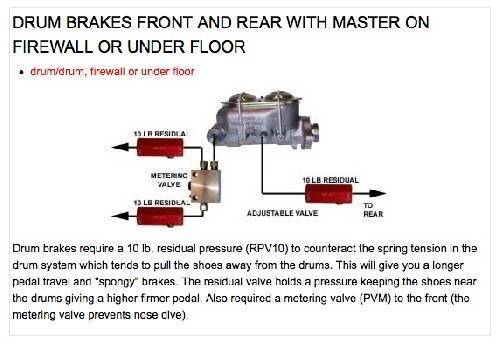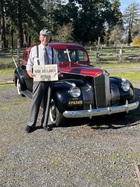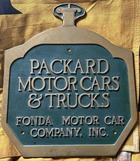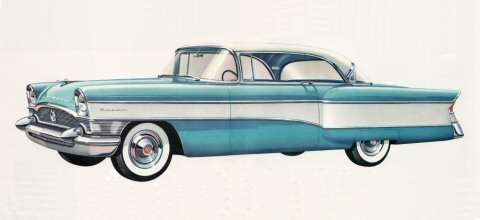|
Re: Modern brakes, part two.
|
||||
|---|---|---|---|---|
|
Forum Ambassador
|
Moved the pedal pad up 1" on the arm so in effect lowered the ratio a tad. That moves the pedal to almost the original location.
Still a bit more sensitive than I'd like and that may be partly due to the fairly heavy pedal pushing down on the linkage. Think I might add another spring on the pedal to make it fairly neutral. If that doesn't help guess I will get used to the feel. With no assist it still stops but does take a bit of effort. Wouldn't want to drive it that way very long. Been so long since I've driven a BTV, can't remember very well how that one compares with no power.
Posted on: 2012/9/5 14:10
|
|||
|
Howard
|
||||
|
||||
|
Re: Modern brakes, part two.
|
||||
|---|---|---|---|---|
|
Home away from home

|
I drove some mid 60's and early 70's BIG Buicks, and a 59 Cadillac. They were very very touchy and good firm pedal. Drove my 56 Exec with BTV for several thousand miles and it was just as touchy and solid as the Buciks and Cad and even some early to mid 60's chevies.
I believe after 30+ years of driving modern power brakes especialy with split systems and front disk we have grown accustom to spongy and less than anything that would be considered high power brake systems. Now with ABS (Anti Stop Brakes) it makes it even more challenging to switch back to older power brake systems. General driving of the Exec is rather sporatic but usualy for at least 50 miles at a time. I find it takes a little getting used to just driving the car in general. Then later on in the day or a few days later i have to get used to driving the 01 Dodge, 89 Caprice or other more modern cars. Steering, brakes, leg positions etc etc. are all different feel. I'm not eligible for SS yet. But i do prefer the feel and drive of the 50's and 60's cars depite their often spongy feel at times. Somewhre after after early 70's cars became something more like a go-cart. Modern cars are too choppy and very unforgiving of any quick or fast movements of controls such as steering, gear shiting (sticks), clutch etc. while the more modern brakes have become spongy.
Posted on: 2012/9/5 14:28
|
|||
|
VAPOR LOCK demystified: See paragraph SEVEN of PMCC documentaion as listed in post #11 of the following thread:f
https://packardinfo.com/xoops/html/modules/newbb/viewtopic.php?topic_id=7245 |
||||
|
||||
|
Re: Modern brakes, part two.
|
||||
|---|---|---|---|---|
|
Home away from home

|
The old full power brakes were a sales item. Later on it was found that only a trained driver could mangage them properly in an emergency. State police forces often opted for manual brakes preferring the superior modulation which performed better on timed pursuit routines.
There is at least one modern car with full power brakes - the Chrysler Dart. They are just like the old days, but with computer control they should do okay in an emergency. The reason residual check valves are not part of the disc brake system is because the calipers must have zero psi to release. Recently I handled a case of spongy brakes in a new car. It was not properly bled at the factory. The symptom was that as the brakes got hot they faded too much. The same symptom as worn out drums. Determining the problem required testing the braking force at each individual wheel. Of course I didn't get paid because these car companies don't like people are intelligent. I've seen people get paid for ruining a new engine, while I get stiffed for diagnosing computer control problems due to shoddy work at the factory. The high amount of brake pedal travel in the modern system is due to the amount of fluid displacement required by the disc brake. The more the pedal moves, the more work is being done. In the duo servo system the motion of the drum provides self energizing action and so displacement is not required - thus the firm brake pedal feel. To see what I am talking about, pump up the pedal on a modern car. It usually is very firm until the motor starts, then the booster takes over and the spongyness is from power assist. Personally I think the only benefit of ABS is that of reducing spin out on ice patches (Fred Duesenberg died after hitting an ice patch with the brakes applied). The problem with TreadlVac is catastrophic failure, worn out drums, and non-availability of asbestos linings. So I can't blame people for trying to do something about that. Personally I think the thing is rotten engineering because it subjects the ram seal to motor vacuum. That is junk. Today's brake systems are engineered for people who don't know how to drive. I know how to modify a brake system to make the pedal feel like a rock, but I don't do it because it would reduce stopping power.
Posted on: 2012/9/5 16:45
|
|||
|
||||
|
Re: Modern brakes, part two.
|
||||
|---|---|---|---|---|
|
Forum Ambassador
|
Further update. The car definitely stops so that I'm happy about -- still more suddenly than I would like and that I'm not. No sign of spongy brakes but do seem to have the nose dive symptom. In researching things to calm it without lowering the ratio, came across this suggestion. Have never seen or heard of this particular valve recommendation other than on disc/drum cars. It's purpose is to allow the rears to apply first then the fronts but is not a proportioning valve since it does apply full pressure -- just delays it.
Also, while MPB says no residual valve is needed with high mount remote reservoirs, this site differs with their opinion using it for all. I will put the front residual valve(s) back but another question arises. In using the metering valve with disc/drum applications they show one residual valve for front between the valve and master yet as you can see, on drum/drum instructions they show two -- one for each front wheel between cylinder and metering valve and a single to the back. Any ideas on why two rather than the one would be beneficial for the fronts? Only thing I can think of is perhaps they are thinking the cylinders could be slow on one side or interact side to side and unbalance the valve. Comments??
Posted on: 2012/9/21 16:36
|
|||
|
Howard
|
||||
|
||||
|
Re: Modern brakes, part two.
|
||||
|---|---|---|---|---|
|
Home away from home

|
1. I assume we are running EVERYTHING as OEM Packard brakes out on the wheels both front and rear.
2. PMCC set a residual pressure that was shared by ALL 4 wheels. 3. Therefore that residual pressure should b maintaned as per PMCC specs. I do not know what that pressure is but i'm guessing at least 7 to no more than 12 pounds. So 10 should be ok. 4. The diagram u posted above is in error relative to every tandem cylinder i've ever seen. The REAR port of the MC(closest to pedal) feeds FRONT brakes. NOT rear brakes as the diagram u posted indicates. 5. The residual pressure valve (RPV) is to keep pressure against the wheel cylinder cups to keep the lip of the cup splayed tite against the bore of the wheel cylinder. THerefore there will be some tension on the upper springs of the brake shoes but that is a side effect, not a purpose. The wheel cylinder cups are not like a shaft seal with a spring around them. Wheel cylinder cups get a titer seal as more pressure is applied. NO pressure will allow some seepage of brake fluid. IT's not like sealing a shaft at all.
Posted on: 2012/9/21 18:57
|
|||
|
VAPOR LOCK demystified: See paragraph SEVEN of PMCC documentaion as listed in post #11 of the following thread:f
https://packardinfo.com/xoops/html/modules/newbb/viewtopic.php?topic_id=7245 |
||||
|
||||
|
Re: Modern brakes, part two.
|
||||
|---|---|---|---|---|
|
Home away from home

|
I'm pretty sure this rite:
If 10# (OEM RPV pressure) is SHARED between FOUR wheel cylinders then that is about 2.5 pounds PER wheel cylinder. IN the diagram it shows 10# to BOTH rear. THat is 5# EACH rear cylinder. But diagram shows 10# to EACH front. I would look at some production car that used tandem cylinder with 4 wheel drum to see what they did. THe problem here is that there may be varied internal designs of variuos tandem mc's. Remeber we are also dealing with aftermarket hotrod suppliers so claims may not be real and may be contridictory among various aftermarket mfg'er's. See if a 65 or 66 Mustang SINGLE line MC will fit your power unit. It has built in RPV. About $30 from AZO and probably o-rilly et-al. The Mustang MC will more closely emulate the OEM Packard set up. EDIT: I'm not sure what PRODUCTION car your power unit is modeled after. IF it is modeled after F then try Mustang, if modeled after CHEV then try 65 Chevy MC. By "modeled after" i mean bolt pattern and recess in the power unit to accept the MC bolt pattern and snout that sticks out of the back of the MC.
Posted on: 2012/9/21 19:09
|
|||
|
VAPOR LOCK demystified: See paragraph SEVEN of PMCC documentaion as listed in post #11 of the following thread:f
https://packardinfo.com/xoops/html/modules/newbb/viewtopic.php?topic_id=7245 |
||||
|
||||
|
Re: Modern brakes, part two.
|
||||
|---|---|---|---|---|
|
Forum Ambassador
|
I haven't decided on the metering valve yet -- still doing research. All of the suppliers do say 10psi residual for drums and 2 for discs. Those are the only two size external valves sold that I can see. All have the same configuration - one per line - except for the site with the metering valve showing the two for front. Still not sure if needed or they just want to sell components.
As to the plumbing on MC, apparently it depends on the MC. MPB has a chart on their support page called master cylinder plumbing for those units they sellhttp://www.mpbrakes.com/technical-support/configurations.cfm Of the 14 shown, looks like 5 have the front wheels coming off the port on front of cylinder.
Posted on: 2012/9/21 19:28
|
|||
|
Howard
|
||||
|
||||
|
Re: Modern brakes, part two.
|
||||
|---|---|---|---|---|
|
Home away from home

|
Is the metering valve adjustable to allow increasing or decreasing pressure to front brakes??????
If it is not adjustable then i doubt that it will solve the nose drive problem. Most likely an adjustable Proportionaing valve is the best thing to try. Do need the RPV(s) tho. The nose dive is partialy due to the OEM suspension design, especialy under hard braking. Does the MC u have now have a SPRING loaded internal dual piston?????
Posted on: 2012/9/22 19:49
|
|||
|
VAPOR LOCK demystified: See paragraph SEVEN of PMCC documentaion as listed in post #11 of the following thread:f
https://packardinfo.com/xoops/html/modules/newbb/viewtopic.php?topic_id=7245 |
||||
|
||||
|
Re: Modern brakes, part two.
|
||||
|---|---|---|---|---|
|
Forum Ambassador
|
Not sure on the piston spring. I didn't take MC apart but I expect it is the typical configuration. It's the same one others have used with their conversions--but with a different booster.
The valve looks like it has something to turn but the operation description just says the valve holds off brake application until line pressure is 75-135psi to give the rear brakes time to apply first. Doesn't give further info unless some instructions come with it. The one site is the only one I've found that mentions it for drum/drum brakes. Several others carry the same valve but list it as used on disc/drum applications. It's not horribly expensive and since I have to take the lines apart again to install the front residual valve anyway, am sorely tempted to order the second residual they suggest along with it and see what happens. Would like to have seen more than one place talk about it for drums though. The car is driveable but just a tad more sensitive than I would like. I think there might be a combination of things going on. Front wheel cylinders are 1/16 larger than stock. They have been that way for years without issue on the BTV but maybe now a problem with the greater and faster volume of fluid this MC puts out. Could also have more pedal ratio than needed for the 7 1/2" dual booster so pressure may be higher than I think. Will check the pressure again and compare to what the BTV was putting out.
Posted on: 2012/9/22 20:45
|
|||
|
Howard
|
||||
|
||||

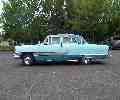
 (35.92 KB)
(35.92 KB)